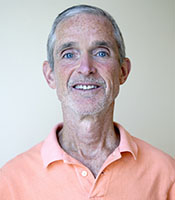Yoga: A True Harmony of Head, Heart and Hands
by Swami Ramananda
Yoga is both the complete experience of our essential Spiritual Self and the practices done to reveal that true nature. It is both a science of self-mastery and the art of pursuing that goal with self-discipline, compassion and contentment.
Yoga
asanas (postures), so commonly known in the West, are only one small part of Yoga and are meant to be performed in the context of a much broader philosophical picture. Otherwise, the numerous benefits of
asana practice, while significant, lack the potential transformational effects for which they originated.
Yoga is a comprehensive way of life that includes numerous branches,
each like a pathway leading to the same mountaintop. These different paths or approaches to Yoga practice heal and develop the various aspects of an individual: social, physical, energetic, emotional and intellectual.
The path of Raja Yoga could be called the path of mental mastery and is presented in the Yoga Sutras of Patanjali, one of the main scriptures that delineate Yoga and its teachings. The Sutras define Yoga as an experience that occurs when the movements of the mind are stilled, and it describes eight limbs or steps to that achievement, which is often called Self-realization.
The Sutras also present the practices of
asana,
pranayama (breathing techniques) and meditation, which can be considered the path of Hatha Yoga. This approach uses the gross, physical level of being, to gradually purify and bring under conscious control the more subtle levels. Ultimately, Hatha Yoga fully awakens the storehouse of superconscious energy, or
kundalini, an experience synonymous with Realization.
The Sutras describe as well the use of sound vibration as an aid for self-mastery, which can be seen as a path by itself called Nada, or Japa Yoga. This practice utilizes sound formulas called mantras, which represent different aspects or qualities of the Spiritual Self. Through chanting and repetition, an individual can attune the entire body-mind system with the divine vibration of the Spirit, and thus attain harmony with it.
The same harmony with Spirit is reached through another branch called Karma Yoga, the Yoga of action through selfless service. This path is described in detail in the Bhagavad Gita, another of the main scriptures that expound the teachings of Yoga. Karma Yoga involves performing duties with a focused mind and loving intention, without attachment to the outcome or to personal reward. When the heart and mind are trained to act for the well-being of all, the practitioner becomes an instrument of the Divine Will, transcending her/his individuality.
The Bhagavad Gita also advocates the path of love and devotion to God in some form, called Bhakti Yoga. Many individuals are naturally inspired to see the Divine Light in a spiritual teacher, deity, symbol or in the infinite magnificence of Mother Nature. Through faith, constant remembrance and devoted service to that representation, one can rise above the illusion of a separate self and experience union with the Spirit that dwells within everything, including oneself.
Yet another branch of Yoga promulgated in the Bhagavad Gita is Jnana Yoga, the path of wisdom. This method requires self-analysis and a keen intellect to practice a steady, systematic discrimination between the unchanging Spirit and the ever-changing forms of creation. By identifying less and less with one’s own body, mind and ego, one comes to experience the Spiritual Self that is normally hidden behind these grosser aspects of being.
Though Yoga emerged in ancient India as one of six schools of Hindu philosophy, all of these paths, teachings and practices remain timeless tools for personal transformation. The more well-known practices—--
asana, guided relaxation,
pranayama and meditation—create numerous physical and psychological benefits and, when properly instructed, can be practiced by anyone, of any age, of any faith. Yoga practice can be reduced to very simple and safe forms, such as slow deep breathing, and is being used therapeutically to treat countless health issues. My teacher, Sri Swami Satchidananda, playfully expressed its simplicity when he said that Yoga means having an easeful body, a peaceful mind and a useful life.
While someone may be naturally drawn to a particular form of practice or one of the branches mentioned here, there is a great benefit to practicing all of them, thus addressing all the levels of our human nature. However, even without this comprehensive approach, any one of them can bring a practitioner to the ultimate goal of liberation and make the journey an enjoyable one.
 Swami Ramananda is the president of the Integral Yoga Institute in San Francisco and a greatly respected senior teacher in the Integral Yoga tradition, who has been practicing Yoga for over 35 years. He was a founding board member of Yoga Alliance®. Ramananda offers practical methods of integrating the timeless teachings and practices of yoga into daily life, and transforming the painful aspects of human experience into steps toward realizing one’s full potential. He leads beginner, intermediate and advanced level yoga teacher training programs in San Francisco, and offers a variety of programs in many locations in the U. S., Europe and South America. Swami Ramananda is the president of the Integral Yoga Institute in San Francisco and a greatly respected senior teacher in the Integral Yoga tradition, who has been practicing Yoga for over 35 years. He was a founding board member of Yoga Alliance®. Ramananda offers practical methods of integrating the timeless teachings and practices of yoga into daily life, and transforming the painful aspects of human experience into steps toward realizing one’s full potential. He leads beginner, intermediate and advanced level yoga teacher training programs in San Francisco, and offers a variety of programs in many locations in the U. S., Europe and South America. |